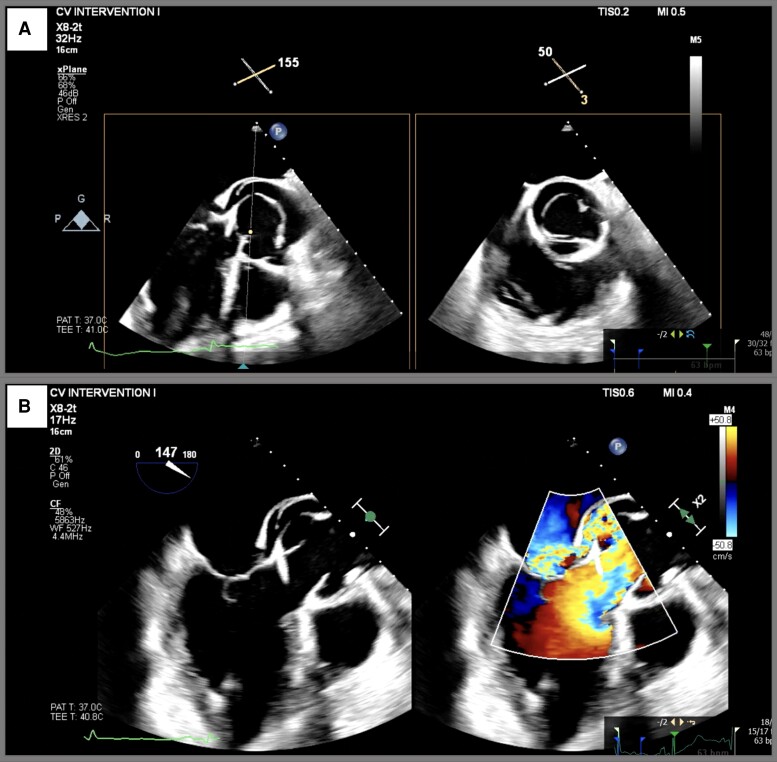A 61-year-old male was admitted to the emergency department for acute dyspnoea and chest pain. He had a previous history of uncontrolled hypertension and peripheral artery disease with amputation of the lower right limb. Vitals were heart rate of 110 bpm, blood pressure of 150/30 mmHg, and pulse oximetry of 89%. A soft diastolic murmur was audible in the left sternal border. Emergent transthoracic echocardiography identified a type A aortic dissection, confirmed by computed tomography (CT)-scan that showed flap extension till the iliac bifurcation (see Supplementary material online, Figure S1). Because of the high surgical risk and the dynamic course of the dissection process, transoesophageal echocardiography (TEE) was performed. TEE showed the helicoidal flap and entrance tear at the level of the Valsalva sinuses with moderate aortic valve regurgitation without valve distortion. TEE also identified a disruption of the mitral-aortic intervalvular fibrosa with a fistula (∼10 mm) between the aorta and the left atrium, producing a continuous high-flow jet (Figure 1 and Supplementary material online, Video S1).
Figure 1.
Transesophageal echocardiogram: Panel A: X-plane view at the mid-esophageal long axis and aortic valve short axis views depicting the type A aortic dissection and the disruption of the mitral-aortic intervalvular fibrosa. Panel B: ‘Color-compare’ view at the mid-esophageal long axis view showing the continuous high-flow jet through the aorto-atrial fistula and the mild to moderate aortic insufficiency.
Replacement of the ascending aorta and closure of the fistula was performed. The patient was discharged 44 days after surgery.
Aorto-atrial fistulas are extremely rare complications associated with type A aortic dissection, especially in the absence of previous cardiac surgery.1 In this case, the CT-scan was crucial for the diagnosis and the TEE for the evaluation of the haemodynamic impact and to guide the surgeons intraoperatively, emphasizing the role of multimodality imaging in these complex scenarios.1,2
Emergent surgery with replacement of the involved aortic segments and direct closure of the fistulas is the treatment of choice to minimize the high morbidity and mortality inherent to this condition.1
Supplementary Material
Acknowledgements
We thank Dr. João Abecasis for the help with the CT images and Dr. Márcio Madeira for the description of the surgical procedure.
Consent: The authors confirm that written consent for submission and publication of this case report including images and associated text has been obtained from the patient in line with COPE guidance.
Funding: This research did not receive any specific grant from funding agencies in the public, commercial, or not-for-profit sectors.
Contributor Information
Mariana Sousa Paiva, Hospital de Santa Cruz, Centro Hospitalar de Lisboa Ocidental, Avenida Professor Doutor Reinaldo dos Santos, 2790-134 Carnaxide, Portugal.
Daniel A Gomes, Hospital de Santa Cruz, Centro Hospitalar de Lisboa Ocidental, Avenida Professor Doutor Reinaldo dos Santos, 2790-134 Carnaxide, Portugal.
Regina Ribeiras, Hospital de Santa Cruz, Centro Hospitalar de Lisboa Ocidental, Avenida Professor Doutor Reinaldo dos Santos, 2790-134 Carnaxide, Portugal.
Lead author biography
 Mariana Paiva, MD, is a Cardiology resident physician at Hospital de Santa Cruz, Centro Hospitalar Lisboa Ocidental EPE, Carnaxide, and Portugal. She plans to pursue a career in clinical cardiology. Her research interests include heart failure, cardio-oncology, sex differences in cardiovascular disease, and adult congenital heart disease management.
Mariana Paiva, MD, is a Cardiology resident physician at Hospital de Santa Cruz, Centro Hospitalar Lisboa Ocidental EPE, Carnaxide, and Portugal. She plans to pursue a career in clinical cardiology. Her research interests include heart failure, cardio-oncology, sex differences in cardiovascular disease, and adult congenital heart disease management.
Supplementary material
Supplementary material is available at European Heart Journal – Case Reports.
Data availability
No new data were generated or analysed in support of this research.
References
- 1. Caruso A, Iarussi D, Materazzi C, Dialetto G, Covino F, Bossone E, et al. Aortic dissection with Fistula to left atrium: diagnosis by transesophageal echocardiography with successful repair. J Am Soc Echocardiogr 2000;13:69–72. [DOI] [PubMed] [Google Scholar]
- 2. Erbel R, Aboyans V, Boileau C, Bossone E, Bartolomeo R, Eggebrecht H, et al. 2014 ESC guidelines on the diagnosis and treatment of aortic diseases. Eur Heart J 2014;35:2873–2926. [DOI] [PubMed] [Google Scholar]
Associated Data
This section collects any data citations, data availability statements, or supplementary materials included in this article.
Supplementary Materials
Data Availability Statement
No new data were generated or analysed in support of this research.



